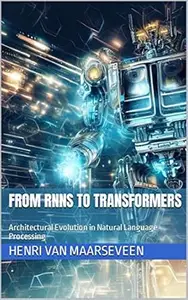
Free Download From RNNs to Transformers : Architectural Evolution in Natural Language Processing
English | 2023 | ASIN: B0C715Q61N | 110 pages | Epub | 1.48 MB
Introduction to Neural Network Architectures in NLP
The Power of Neural Networks in Natural Language Processing
Neural networks have revolutionized the field of Natural Language Processing (NLP) by enabling computers to understand and process human language in a more sophisticated manner. Traditional rule-based approaches and statistical models had limitations in capturing the complex patterns and semantics of language. Neural networks, on the other hand, mimic the structure and functioning of the human brain, allowing machines to learn and make sense of language data.
Foundations of Neural Networks
To understand neural network architectures in NLP, it is essential to grasp the fundamental concepts. At the core of neural networks are artificial neurons, or nodes, interconnected in layers. Each neuron receives inputs, performs a mathematical computation, and produces an output signal. These computations involve weighted connections and activation functions, which introduce non-linearity and enable complex mappings.
Neural Network Architectures for NLP
Feedforward Neural Networks
Feedforward Neural Networks (FNNs) were among the earliest architectures applied to NLP tasks. FNNs consist of an input layer, one or more hidden layers, and an output layer. They process text data sequentially, without considering the sequential nature of language. Despite their simplicity, FNNs showed promising results in certain NLP tasks, such as text classification.
Example: A feedforward neural network for sentiment analysis takes as input a sentence and predicts whether it expresses positive or negative sentiment.
Recurrent Neural Networks (RNNs)
RNNs introduced the concept of sequential processing by maintaining hidden states that carry information from previous inputs. This architecture allows the network to have a form of memory and handle variable-length sequences. RNNs process input data one element at a time, updating their hidden states along the sequence.
Example: An RNN-based language model predicts the next word in a sentence by considering the context of the previous words.
Long Short-Term Memory (LSTM) Networks
LSTM networks were developed to address the vanishing gradient problem in traditional RNNs. They introduced memory cells that can selectively retain or discard information, enabling the network to capture long-range dependencies in sequences. LSTMs became popular for tasks such as machine translation and speech recognition.
Example: An LSTM-based machine translation system translates English sentences to French, capturing the nuanced meaning and grammar.
Gated Recurrent Unit (GRU) Networks
GRU networks, similar to LSTMs, were designed to mitigate the vanishing gradient problem and improve the efficiency of training recurrent networks. GRUs have a simpler structure with fewer gates compared to LSTMs, making them computationally efficient. They have been successfully applied to various NLP tasks, including text generation and sentiment analysis.
Example: A GRU-based sentiment analysis model predicts the sentiment of social media posts, helping understand public opinion.
Limitations of RNN-based Architectures in NLP
While RNN-based architectures demonstrated their effectiveness in NLP, they have certain limitations. RNNs suffer from difficulties in capturing long-term dependencies due to the vanishing gradient problem. They are also computationally expensive and struggle with parallelization, hindering their scalability to large datasets and complex tasks.
Code:
Bitte
Anmelden
oder
Registrieren
um Code Inhalt zu sehen!